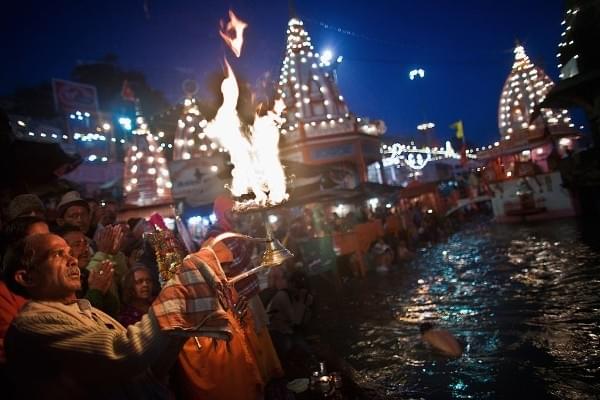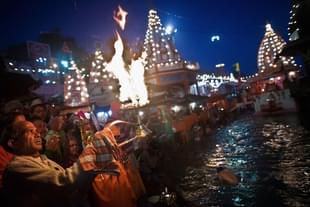Magazine
The Hindutva Manifesto
Arihant Pawariya
Mar 05, 2019, 07:52 PM | Updated 07:52 PM IST
Save & read from anywhere!
Bookmark stories for easy access on any device or the Swarajya app.


What defines a nation’s identity? It could be shaped by a number of factors - common language, culture, customs, traditions, ethnicity, religious belief, birthplace, etc. Which features are present in lesser or greater degree may vary depending on historical trajectory of a nation but it is invariably a combination of these factors that underscores a people’s sense of belonging. China views itself as a civilisation of ethnic Han people. The United States is informed by Judeo-Christian ethics, France by Catholicism, Britain by Protestantism, Israel by Jewish values and so on. The Japanese, despite being flanked by powerful Chinese and the Western civilisations have a unique sense of their own culture and heritage. Muslim majority countries across the world have a very clear idea of their identity.
More importantly, these people, confident of who they are, have established states which strive to strengthen their national identities and promote their cultural values.
India is an aberration. It is clueless about its national identity. Ideally, at its core should be Hindus, who through the ebbs and flows of history, have nourished the Bharatiya civilisation, nurtured its culture, composed its languages, and kept the traditions alive: those who feel the pain of Somnath, swell with pride on listening to exploits of Shivaji, see the divine in country’s rivers, lay claim as the cultural heirs to Indus-Saraswati civilisation and believe this land to be both their karmabhoomi and punyabhoomi.
That is not the case. Despite the British imperialists leaving in 1947 and despite excising a large, malignant tumour of Islamism (albeit at an unacceptable cost), the Hindu society didn’t get a new lease of life it had hoped for. Its art, literature, music, architecture, philosophy, theology, etc were crying out loud for redemption. After all, for 800 years, Hindus were in majority but out of power. Unfortunately, post independence too, political sovereignty didn’t translate into State patronage for Hindu society. Worse, the new republic soon transmogrified into a hostile nanny state which in its modernising zeal not only tried to snuff out vestiges of anything Indic through alien education imparted in an alien language but it also started disarming the temples which could have infused new life into moribund Hindu society.
As if this wasn’t bad enough, the chains of socialism held the country captive in utter poverty. Hungry stomachs don’t a renaissance make.
We as a nation remained weak.
Only in the 1990s, the soul of the nation long suppressed started founding utterance thanks to opening up of the economy, the Ram Janmabhoomi movement and the telecast of nation’s grand epics, Ramayana and Mahabharata into homes of ordinary Indians. Hindu nationalists rode to power on the back of this resurgence. The BJP championed the cause of Hindutva; however, in a narrow sense, focusing mainly on three issues: building a temple in Ayodhya, abrogating Article 370 in Kashmir and bringing a uniform civil code.
Despite more than a decade in power, the party has nothing to show for on these fronts. It wields a cultural issue (like Sabarimala) only if it wins votes (but won’t solve the crisis by bringing an ordinance). Beyond electoral consideration, it doesn’t seem interested in culture wars. Perhaps that’s why, it hasn’t shown any interest or inclination to broaden the horizon of the Hindutva cause.
It doesn’t mean that only the BJP has to do everything. All those who are emotionally invested in their country’s future have a responsibility to come up with a plan, a manifesto, which can best serve the society. What should such a Hindutva manifesto be like?
We will arrive at the fundamentals of such an agenda by working backwards.
The importance of preserving, protecting and propagating Sanatana Dharma is beyond debate. But Dharma cannot be sustained if the Hindu Society withers away. The latter is a vehicle that has carried the former through countless struggles and seemingly insurmountable challenges over millennia.
The first order of business, therefore, has to be to not just keep the demographic advantage of Hindu society intact but make concerted attempts to go from strength to strength. It must be the State’s duty to constantly devise policies towards that goal. The priority should be to proactively work in changing demography in Kashmir by constructing Hindu settlements in the valley followed by resettling Pandits in their native land. Reversing demographic invasion of Jammu and border states like Assam and West Bengal should equally be on top of the agenda. This wound is festering due to apathy of the directionless Indian state towards people of indigenous faiths.
It is also critical to understand the nature of two international majority religions - Islam and Christianity - which pose the biggest threat of changing the very nature of Indian society. They are similar in the sense that both use asymmetry in laws to increase their numbers (in case of the former) and their power or hold in society (in case of Christianity).
India better learns from history.
Christianity was born in the Near East. But Islam become a dominant religion in no time. How? Nassim Nicholas Taleb attributes it to two simple asymmetries: a) “if a non Muslim man under the rule of Islam marries a Muslim woman, he needs to convert to Islam – and if either parents of a child happens to be Muslim, the child will be Muslim. Second, becoming Muslim is irreversible, as apostasy is the heaviest crime under the religion, sanctioned by the death penalty.” Thus a small rate of interfaith marriages was enough to reach a certain threshold of population which was formidable enough to put up a fight and win. First it was Christianity’s intolerance that swallowed the pagan Roman empire. Then Islam did the same to Christianity.
Christianity has largest clout in the education sector and “service” is its soft power. Thanks to the minority tag, the community’s institutions - both religious and educational - are exempt from state’s oppressive regulatory regime that torments and punishes only those run by Hindus. Billions of dollars that are pumped into ‘service’-NGO complex thanks to generosity of fellow co-religionists in uber rich countries go into harvesting souls and fomenting tensions in India. The majority, shorn of any institutional or money power, is left defenceless by the law.
So, any asymmetries must be done away with. Outlawing polygamy and bringing a legislation for population control for those communities in which total fertility rate is more than the national average could be a good start.
To fight predatory global players from hurting the interests of people of indigenous faiths, the Indian state should not only ban all foreign funding to troublesome organisations, it also should nationalise all Church and Waqf properties worth billions.
Can India remain Hindu if it makes the same mistakes that Roman pagans made or Christians in mediterrannian did? Being tolerant of the intolerant is nothing but death wish.
But many Hindus don’t understand the importance of sustaining Dharma. Maybe they are not interested in such a venture or do not know the history of the struggle their society has gone through especially in the last 1200 years or they fail to recognise the residues of exclusivist ideologies that have tormented our nation all these centuries which are very much embedded in the body politic even today.
Cure of all these ailments is educating our children right. Only then can we hope to recover the lost ground. It cannot happen if we surrender the right to educate our students to so-called minorities by punishing the institutions run by Hindus via onerous regulations while exempting those of the “others”.
The history syllabus has to be thoroughly revised exterminating any Marxist narratives from the textbooks and replacing them with nationalist discourse. If we don’t, our own future generations, wallowing in self-loathing, will work to uproot everything we hold dear - our myths, history, heroes, rituals, festivals, traditions and what not.
Article 28 mandates that, “No religion instruction shall be provided in any educational institution wholly maintained out of State funds”. Now, what is a religious instruction? If we were to strictly go by the abrahamic concept of “religious denomination” test, then every ritual, tradition or practice that has evolved in this land over centuries is Hindu and thus religious, and therefore, to be shunned. No wonder we are hearing calls for banning of Sanskrit prayers in school morning assembly.
We have to understand that Indian and Hindu culture are synonymous with each other. Hence, students must be rooted and well versed in their country’s culture. Deracination is not a virtue. In fact, no education institution should receive any funds from the state which doesn’t impart India’s heritage to children as part of their formal schooling.
It is also of utmost importance that children in all parts of the country are taught in Indian languages. There is nothing secular about languages as is commonly believed. They are intimately connected to the faith, traditions and culture of the people who have developed them. If we want to preserve and pass on these to future generations, teaching in Indic languages is a must.
Lastly, we must never be tired of repeating that India is primarily a Hindu nation. This nature of Bharat can’t be allowed to change, otherwise its culture, heritage, the very civilisation as we know it will cease to exist. But the Indian State is trying to do just that using the constitution which is being increasingly seen as an anti-Hindu document.
Hindu nationalists have their work cut out for them. For decades now, they have insisted on working in the society to change things. Most of them (including top RSS leaders) can be found using the term Hindu rashtra but not Hindu rajya. They have left the State open for takeover by the other side. This space needs to be reclaimed. In the age of nation-states, any attempts to forge a nation without State’s active involvement would fail.
Some very obvious principles need to be categorically stated and inserted into constitution.
That Bharat, the Indian subcontinent, is historical, cultural and natural homeland of Hindus, the followers of Sanatana Dharma, who, thus, logically, are first among equals in the citizenry of the country. It is they who have the foremost right to decide the nature of the state that best secure their way of life. In fact, it should be duty of the State to protect, preserve and promote the historical, cultural and religious heritage of people belonging to faiths indigenous to this land.
That the State will do the same even for those in the diaspora.
That any member of the diaspora, who feels threatened in his country of residence/nationality due to his or her Indic identity must have the first claim on immigration to India.
That Ramayana and Mahabharata are two national epics of the Indian nation.
That Sanskrit language, in which preponderance of our sacred texts are written, should enjoy a special status along with other ancient Indic languages.
India is already a Hindu rashtra. To keep it as such, Hindu rajya is a necessity.
Arihant Pawariya is Senior Editor, Swarajya.





